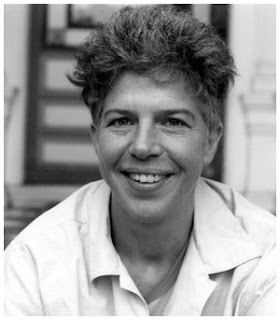Bois-Charbons

Monday night, Oberlin College hosted filmmaker and Obie grad Su Friedrich, one of the most interesting and important avant-garde filmmakers of the last thirty years. She screened three of her films-- Rules of the Road (1993), The Head of a Pin (2004) and Seeing Red (2005)--and spoke with students following the screening. Smart, funny and self-deprecating, Friedrich was a delight to meet and listen to, and her work raised all kinds of interesting questions about the intersections of film form, social space and autobiography.
All three films, with running times of 20-30 minutes each, operated in an almost Surrealist fashion: meaning derived less from linear narrative (although there was either dialogue or narration in each) than from the associative patterns that Friedrich's gathering of images teased out. It felt reminiscent of what Andre Breton wrote in Nadja, about his walking tour through Paris:
The words BOIS-CHARBONS, which appear on the last page of Les Champs Magnetiques, enabled me, during the whole of one Sunday I spent walking with Phillipe Soupault, to exhibit a peculiar talent for detecting every shop they serve to designate…And my predictions always turned out to be right. I was informed, guided, not by the hallucinatory image of the words in question, but rather by one of those logs in cross-section, crudely painted on the façade, in little piles on each side of the door, all the same color with a darker center.
What matters, in other words, is less the meaning of the word, then the sensation provoked by the accompanying image; the usefulness of “bois charbons” is not that it informs Breton of where to buy charcoal (the loose translation of the term), but that it allows him entrance to a transformed world, one mediated by images (a far less “stable” signifier than words). Similarly, Friedrich's starting points-- a beat-up Oldsmobile in Rules of the Road, a recurring image of a spider-bug match (like something out of Bunuel) in Pin, and the spectacular gathering of red objects in Seeing Red-- are less symbols than generators or hyperlinks, vehicles that allow her to negotiate the physical and emotional terrain of each picture. Rules documents the arc and dissolution of Friedrich's relationship with a girlfriend, with whom she shared the Olds, and was inspired (she said in the Q & A), by walking out of her apartment one day, seeing an Olds go by, and wondering if it was the ex. Taking this as a starting point, she began to notice just how many Oldsmobiles there were in her neighborhood-- an automotive equivalent to Breton's firelogs--and to document their movement around the city.
 Out of this collection of images, Friedrich begins to weave tales of romance, daytrips, childhood family car trips, and anxieties about environmental decay, as her first-person narration plays over Olds images, and we begin to wonder (like Friedrich on the stoop that day) if this is "the" car she keeps talking about, or just another model passing through.
Out of this collection of images, Friedrich begins to weave tales of romance, daytrips, childhood family car trips, and anxieties about environmental decay, as her first-person narration plays over Olds images, and we begin to wonder (like Friedrich on the stoop that day) if this is "the" car she keeps talking about, or just another model passing through.An even more impressive, almost Benjaminian collection of images occurs in Seeing Red, as the film opens with a plethora of red objects: stop signs, neon signs, bookbags, bicycles, sports gear, t-shirts, dyed hair. It's a logic of the object-- gather everything you can in one color-- rather than the idea (This "means" such-and-such). Following this red prelude, Friedrich eases herself into the picture-- literally, this time, as we see part of her red t-shirt, and she starts to monologue about her daily life, her ennui, and her fears and hopes for the future. We never see her face-- just her chest, neck, and the corner of her chin, an off-center framing that emphasizes the voice, and suggests the "real" body here is the cinematic one she is constructing (as the film continues, it cuts back and forth between this image of Friedrich and more montages of red objects).
 There's a musical rhythm to the film that's enhanced by the Glenn Gould on the soundtrack-- it feels both orderly and loose, a kind of controlled chaos that invites the reader to complete the portrait Friedrich is crafting. She notes, at one point, that red is a terrible color for video-- that it never turns out right and can seem too strong, but her own work belies this claim: like the red that dominates the movie, her aesthetic pushes the viewer into new cinematic frequencies, and reminds him that what seems off-kilter, challenging or "new" can also be inviting, enlightening; it offers new forms of beauty, and new ways of moving through a space.
There's a musical rhythm to the film that's enhanced by the Glenn Gould on the soundtrack-- it feels both orderly and loose, a kind of controlled chaos that invites the reader to complete the portrait Friedrich is crafting. She notes, at one point, that red is a terrible color for video-- that it never turns out right and can seem too strong, but her own work belies this claim: like the red that dominates the movie, her aesthetic pushes the viewer into new cinematic frequencies, and reminds him that what seems off-kilter, challenging or "new" can also be inviting, enlightening; it offers new forms of beauty, and new ways of moving through a space.


Comments